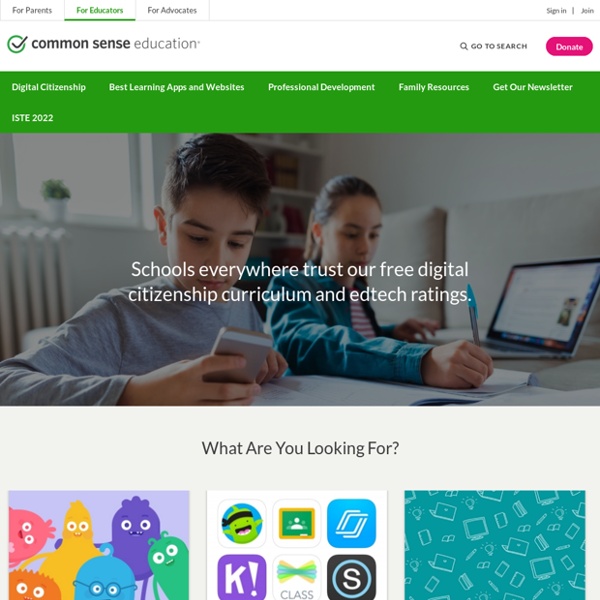



https://www.commonsense.org/education/
Related: Week 6: Managing Instruction (* = Key reading) • Integrating Technology across Content Areas • To be categorized • Education System • Websites to Check Out*Robert Mager's Performance-Based Learning Objectives (useful for your Assignment 3: Critical Issues Workshop!) You don’t have to read up on learning objectives for too long before you run into the name of Robert Mager and hear about his performance-based learning objectives. These are also sometimes called three-part learning objectives or behavioral learning objectives. This isn’t necessarily the only way to write learning objectives. SETDA - Case Studies 2012 Under current and prior incarnations of the the Elementary and Secondary Education Act of 1965 (ESEA), Congress granted the U.S. Department of Education specific responsibility to support states and school districts to improve student academic achievement through the use of technology. In 2010, the Obama Administration released its blueprint for the reauthorization of ESEA and in parallel ceased requesting federal budget support for educational technology programs in continuous operation since 1994.
What are the 21st-century skills every student needs? The gap between the skills people learn and the skills people need is becoming more obvious, as traditional learning falls short of equipping students with the knowledge they need to thrive, according to the World Economic Forum report New Vision for Education: Fostering Social and Emotional Learning Through Technology. Today's job candidates must be able to collaborate, communicate and solve problems – skills developed mainly through social and emotional learning (SEL). Combined with traditional skills, this social and emotional proficiency will equip students to succeed in the evolving digital economy. What skills will be needed most? An analysis of 213 studies showed that students who received SEL instruction had achievement scores that averaged 11 percentile points higher than those who did not. And SEL potentially leads to long-term benefits such as higher rates of employment and educational fulfillment.
21 Skype Lessons For Active Learning, Sorted By Topic Continuing our mini-series on using Skype in the classroom, I wanted to present a few of the many Skype lessons that are currently available for classrooms and everyone else to try out. What is a Skype lesson, you ask? It’s simply a pre-planned ‘call’ where you can watch and learn from others via Skype. Like a Google+ Hangout or other live video-based lesson.
*Why Ownership? ( Hilda K. Weisburg) Although it’s been around for a while, “ownership” has become one of the latest buzz words. It has always been important for you as a leader to own your library program, but there are others who need ownership as well. Owning leads to lifelong learning for students, and involvement and investment in your program from teachers and administrators. Consider the difference in renting or owning a home. If you rent a home and are conscientious you keep it in good order and that’s about it.
Examples of Technology Integration with Young Children Key Messages When used intentionally and appropriately, technology and interactive media are effective tools to support learning and development. Intentional use requires early childhood teachers and administrators to have information and resources regarding the nature of these tools and the implications of their use with children. How much money teachers earn around the world How much do educators get paid for their work? We asked 16 public school teachers in communities around the world — from Kildare to Kathmandu, Johannesburg to Oslo — to tell us what they earned in one month (and how they spent it). Here’s what they said: Toronto, Canada Tell us about yourself: I’m 32 years old; I’m a middle school Special Education teacher working for the Toronto District School Board.
Reader's Theater Scripts and Plays for the Classroom Reader's Theater Scripts and Plays Readers Theater is a dramatic presentation of a written work in a script form. Readers read from a "script" and reading parts are divided among the readers. No memorization, costumes, blocking, or special lighting is needed.
All the good stuff from Common Sense Education with tips on using edtech in the context of their reviews, privacy information, and digital citizenship resources. by trishpearson Apr 6